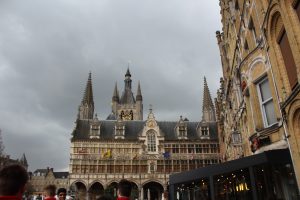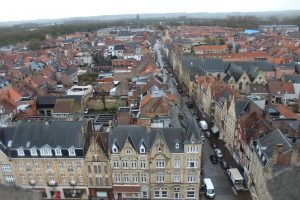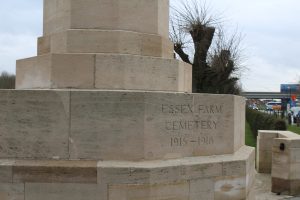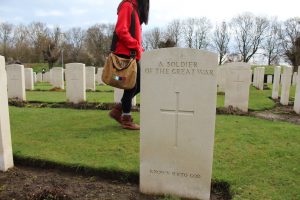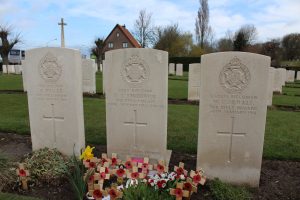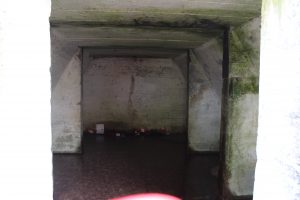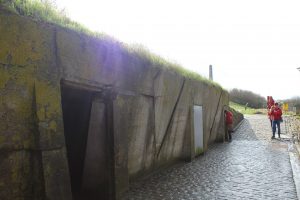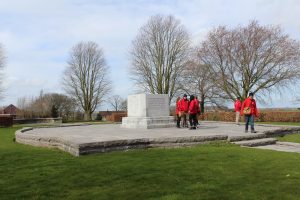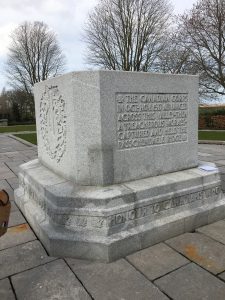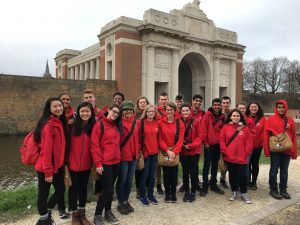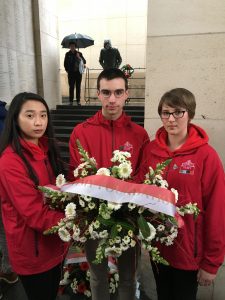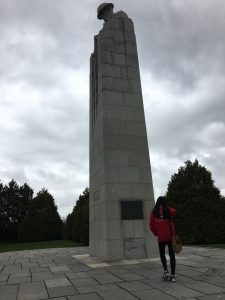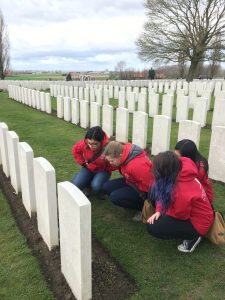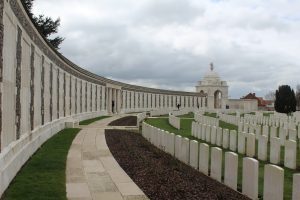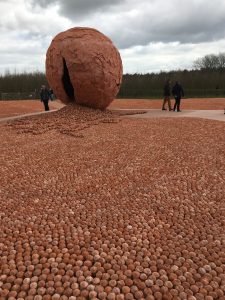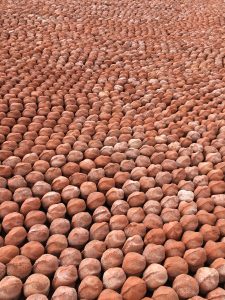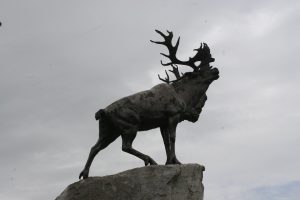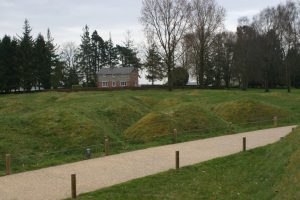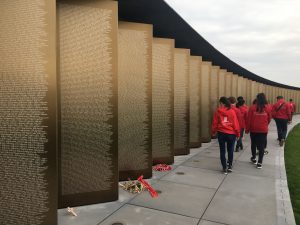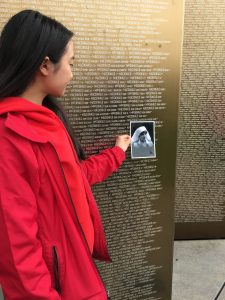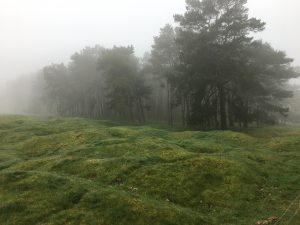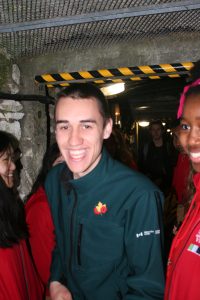So…
Where do I begin? A little over two months ago, I embarked on a life-changing experience, with nineteen other Canadians, who, until April 2, 2018, I had only met online on a Facebook group chat. The funny part is that I didn’t even know that all this was gonna happen.
Two months ago, I went on the Vimy Pilgrimage award— to learn more about it, check out this post. After coming back, a few teachers asked me to do a presentation about my experience, and since I wanted to share the story of the Battle of Vimy Ridge with as many people as I could.
This is all of us in the Montréal airport right before embarking on the plane to Brussels. Air Canada, one of the sponsors of the program, was kind enough to give us drawstring bags (at the bottom of the photo) filled with useful stuff for our voyage. A perfect beginning!
After landing in Brussels, we had a two-hour bus ride ahead of us to Ypres, a small town close to the Belgium-France border. The first site we went to see was the Ypres Cloth Hall: the oldest building of the whole town. During the First World War, when the Germans seized the town, they destroyed everything in sight except the Cloth Hall, because of its high point of advantage. Our tour guide Lucas said that the First World War was just about height: the higher you went, the better you could see your enemy and plan for his arrival. And as you can see, you can almost see the whole town on top of the Cloth Hall, making it a valuable possession for the Germans. After the war, they did go and re-build the town to make it look the way it was before.
(So every building in this picture was built post-war.)
Next stop, The Essex Farm Cemetery and John McCrae’s Dressing Station. So the Essex Farm Cemetery was a British or Commonwealth Cemetery, and in each of these cemteries, there was a sacrificial cross and stone, on the latter was written: Their name liveth forevermore. These words were chosen by Rudyard Kipling. The whole phrase is actually: Though their bodies be buried, their name liveth forevermore. But since there were also Sikh soldiers who fought in the First World War, Kipling chose the second part to not disrespect their religion.
This was written at the bottom of the sacrificial cross. In the Essex farm cemetery alone, a little over 1000 soldiers are believed to be buried and there are over 100 unknown graves, like the one below.
You could also buy a wooden cross and put it at the grave of a soldier as a sort of sacrifice, but why does the grave below have so many? Because that’s the grave of a fifteen-year-old British soldier: Valentine Joe Strudwick.
(This is a photo that Valentine Joe’s biographer likes to think is him, but there exists no actual photo of him.)
If you don’t know, John McCrae was the man who wrote In Flanders Fields. During the First World War, he worked as a doctor, and we got to visit the stop where they believe he wrote the famous poem.
(It was so impactful to stand in here and imagine what was happening a hundred years ago. )
This is the outside of the dressing station, that was right beside the cemetery. What would happen is that the soldiers would line up outside and on top of the station to receive their dressing. After, if everything was alright (depending on the situation), the soldier would go back to the front, if not, he would be sent to England to receive long-term treatment in a hospital, and if he died, he would be buried in the Essex Farm Cemetery.
The Battle of Passchendaele or the Third Battle of Ypres. By far, the most infamous battle of the First World War. The battle raged on for three months and a half of heavy trench warfare. It resulted in a victory for the Allies, but by then, almost a third of their troops were badly injured or killed. Historians have estimated that almost 4 500 000 shells were launched only in the Battle of Passchendaele. But, what’s horrifying to think about (on top of that), is that we don’t know how many shells exploded. So there still are shells buried in Belgian soil from the First World War. And incidents still happen where someone walks onto a non-exploded shell and gets seriously injured or killed even. This is so big of a problem that there is a service for this in Ypres. If you find a shell in your backyard, place it at the bottom of a lamppost and once a week a truck comes and collects them, to properly dispose of them in a closed environment. If you think that it will explode soon, there is even a hotline to call.
When they were choosing a memorial to commemorate the Battle of Vimy Ridge, they had a competition and this design came in third. It is also used to commemorate five other First World War Battle Sites.
The Menin Gate Memorial is a British memorial that commemorates the 54 000 soldiers of the British Empire who died before August 16, 1917, and that have no known grave. Every night, since the end of the war and except during the German occupation in the Second World War, a ceremony happens there, and we were lucky enough to be there for the 31 000th ceremony.
Jeriann, Damien, and Amy also had the chance to participate in the ceremony.
The St. Julien Memorial, or the Brooding Soldier, is a memorial to commemorate the Second Battle of Ypres or the first time toxic gasses were used in the history of warfare. This design came second in the competition for the Vimy memorial. One thing that fascinated me a lot during the program was to see the amount of thought and effort was put into designing these memorials. I don’t have any pictures, but the gardens in front of the memorial were so symbolic. You wouldn’t have noticed it if someone hadn’t explained it to you. On one side of the path, there was a shrub that was kept low, to represent the gas hanging low and moving towards the Allies. On the other side, there were daffodils, to represent the explosions of the shells that were launched right after the gassing. Although the Second Battle of Ypres was one with very high casualties, it was still a victory for the Allies.
The trees behind the memorial are not native to Belgium, they actually come from Canada. “If we can’t bring the boys home, we’ll bring home to the boys.”
The Tyne Cot Cemetery is the biggest British Cemetery with 11 695 soldiers buried, but with 8 369 unknown headstones. As you can see, all the spaces between the stones are equal, this characteristic is unique to the Tyne Cot Cemetery. If you go in other cemeteries, some of the stones are right beside each other, meaning that the soldiers both died on the same day. But since this cemetery was built after the war, the Commonwealth Graves Commission cared about the aesthetic of the graveyard. One small problem was there were some cases where, excuse me being graphic, they couldn’t identify who was who. And since they couldn’t bury all the bodies horizontally and give each soldier a separate unknown headstone, they had to make a mini mass grave. We saw headstones that had: Eight soldiers of the Great War written on them.
The Coming World Remember Me Memorial was created this year to commemorate the centenary of the Armistice. It contains 600 000 handmade statues to represent every Belgian life lost on Belgian soil. (It’s also the number of Canadian soldiers who served in the war.) The cracked egg in the middle represents the Earth and the lives are spilling out of it. What happens after 2018, is that they will put the statues on auction, and fill the egg with 600 000 name plaques so that future generations remember of the sacrifice that happened.
During the First World War, Newfoundland was its own colony and wasn’t part of Canada, but it suffered heavy losses in the war— almost 90% of its troops were killed. This caused its economy to collapse so, they voted and Newfoundland joined Canada. Most of the casualties were during the Battle of the Somme, so to commemorate Newfoundland’s sacrifice, there is the Beaumont-Hamel Memorial. A lot of people think that the animal is a moose, but, they’re wrong, it’s a caribou. Why a caribou? Since it’s native to the province. The same idea comes back: “We couldn’t bring the boys home so we brought home to the boys.”
It’s not very clear in this photo, but there is an electric fence around the green area since there are still unexploded shells; they couldn’t risk having people walk on the hills. So, in order to cut the grass, they have sheep, since they are light enough.
The Ring of Remembrance is also a new memorial. It is a list of the 9 million people who were killed during the war. However this number is still being debated upon today, since we’re still having trouble defining what we consider a war dead. Is it someone who was killed during the war, who died of his wounds after the Armistice, or even is it someone today who accidentally walked on a shell in their backyard? But 9 million is the accepted number. What was more shocking to see was the three panels that had J. Smith written on them.
So logically, you would think all these names would be those of men, soldiers who were killed during the war, right? But the photo Jeriann is holding up is that of a Canadian nurse that was killed in action, and who also attended her (Jeriann’s) high school in Ontario.
The Notre-Dame de Lorette Cemetery was by far one of the most touching sites we went to during the week. The biggest French cemetery, it contained over 22 000 graves. The graves, were head-to-head, instead of head-to-foot, as in the British cemeteries.
The Vimy Memorial, the climax of our week. We went to visit it early in the morning, so nobody was there, and we saw it slowly emerge from the heavy fog. The Battle of Vimy Ridge took place on April 9-12 1917. Canada, during these years had a population of 8 million and sent over 600 000 Canadians overseas, 60 000 were killed and 400 000 served in the Battle of Vimy Ridge. The Battle of Vimy Ridge was Canada’s first time coming onto the world stage as a united force and country. Unfortunately, only 30% of Canadians know about such an important event and sacrifice in Canadian history.
There is also a ceremony that happens there every April 9th. This photo was taken just before the ceremony started. These aren’t veterans of the First World War, since the last one died in 2009, he was 109 years old and also Canadian.
Same thing with the Beaumont-Hamel Memorial. There were still shells buried in the ground and electric fences stopping us, so we couldn’t walk on the land there.
This is by far my favorite photo of the whole trip. Why? Well, this is Florent:
We met at the Beaumont-Hamel memorial, he works as a guide for the Government of Canada and comes from Saguenay, Québec. He gave us a guide and we were all sad to leave him. But, we met him again at the Vimy Memorial. After going through the Vimy tunnels with Florent, we were taking a group photo when we asked him to join us, which he did, but we weren’t expecting his sudden pose. We didn’t even know they took the photo. I think it really captures the spirit of the second family I made on this trip.
Stay tuned for more on my experience….


